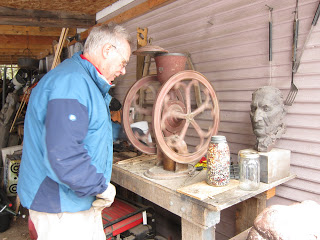When the US of A started using corn to power SUVs with ethanol, it occurred to me that it might just be possible to make my own fuel for the chainsaw. I mean, is it possible to power my saw with fuel I make? Cars run on it. Sure, there has to be some modification to the motors by why not adjust the ethanol, say add cooking oil from sunflowers, and see if it was possible to have a sustainable chain saw.
Of course, it would be hard to build a chainsaw with ethanol, especially self-made fuel, but that is another discussion that I don't want to have because it gives me a headache.
So the first thing I did was secure some possible grains for fermenting, this included Indian corn which is none GMO, some yellow corn which is GMO and designed to make fuel, malted barley, malted rye and some good old white sugar to boost production. All of this was ground up with a hand-driven coffee grinder by Dave from New York. He particularly enjoyed doing it as it made him decidedly sustainable--imagine just human power. I grew the Indian corn, so at this point we are really down-home and personally close-to-the-earth----so to speak. We still had not put on the banjo/fiddle music but did once inside and up close to a couple of nice beers.
I know some will note that the grain mix also might appear to have a similar ratio to what is called beer, and if one looks closely, it might also appear to be the ingredient for what is known as agua vitae, or eau de vie. But initially, I saw it as fuel and not "The Water of Life---at least for a while.
The entire mix, some 15 Lbs, was put in a vat and heated to 140-150 degrees which by all accounts turns the starches to sugar. We did this by carefully heating it over the wood-burning cook stove, thus again being very sustainable. This sugar is a favorite snack of yeast which gobble it up so as to reproduce themselves at a prodigious rate. In the process, they have a waste product known as ethanol, our target chemical. Once they have eaten all the food they die off, just like any species that consumes all it resources. Oh, a few survive and can be revived with more sugar. It is like going through a classic population bottleneck. Some have asked if humans are smarter than yeast.
Once the fermentation is over, after about 5-7 days, then it is possible to either drink the beverage in the form of beer (which, by the way is real fun) or to distill the stuff and extract the ethanol for the chain saw. We used a simple device made of a stainless pot, a cooper tube, and a cooling bucket for condensation. Once the "product" is dripped out, it can be stored in a wooden barrel or in jars filled with charcoal. This makes it turn a nice brown color and when it burns in the saw it smells real nice.
Anyway, we discovered one can make this ethanol from almost anything that has corn sugar, or natural sugars, (even horse milk I read) in it, which is interesting because that means almost everything we eat from the supper market is potential fuel. I personally believe a turnip and a rutabaga can also be used but the smell might be a bit rough. It is my plan to try the first batch in the hit and miss engine because they are indestructible. I love being sustainable.




No comments:
Post a Comment